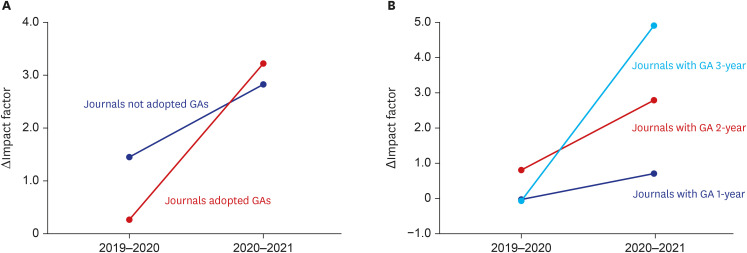J Korean Med Sci.
2022 Nov;37(45):e321. 10.3346/jkms.2022.37.e321.
Seeing Is Believing: The Effect of Graphical Abstracts on Citations and Social Media Exposure in Gastroenterology & Hepatology Journals
- Affiliations
-
- 1Department of Internal Medicine, Soonchunhyang University School of Medicine, Bucheon, Korea
- 2College of Medicine, Soonchunhyang University, Cheonan, Korea
- 3Medical Library, Soonchunhyang University Bucheon Hospital, Bucheon, Korea
- KMID: 2536128
- DOI: http://doi.org/10.3346/jkms.2022.37.e321
Abstract
- Background
Graphical abstracts (GAs) have recently been included as an essential element in various journals, including those in the field of Gastroenterology & Hepatology. However, there has been no study on the effect of GAs on the impact factor (IF) of journals, and the citation index or social media exposure of individual articles.
Methods
We investigated the presence of GAs, total citations and social media exposure of full-length original articles in the top ten journals of gastroenterology and hepatology for three years (2019–2021). Citations and social media exposure were evaluated with the Web of Science citation index, Altmetric Attention score, Dimension recorded citation count, and PlumX index.
Results
A total of 4,205 articles from ten journals were evaluated for three years. First, journals that have adopted GAs demonstrated significantly higher IF increases for the past three years than those of journals without GAs. The longer GAs have been utilized in a journal, the higher IFs the journal had. Secondly, individual articles with GAs had significantly higher Web of Science citation counts (median 14 vs. 12), more social media exposure (median 23 vs. 5) and more Altmetric.com tweet counts (median 15 vs. 7) than those of articles without GAs. In multiple regression analysis, the inclusion of GAs was particularly effective in increasing the number of Web of Science citations (β = 14.1, SE = 1.9, P < 0.001) and social media exposure (β = 13.3, SE = 6.1, P = 0.030) after adjusting for journal IFs and topics.
Conclusion
GAs are effective in increasing IFs of journals in the field of gastroenterology and hepatology, as well as increasing citations and social media exposure of individual articles.
Keyword
Figure
Reference
-
1. Yoon J, Chung E. An investigation on graphical abstracts use in scholarly articles. Int J Inf Manage. 2017; 37(1):1371–1379.2. Yeung AW, Kletecka-Pulker M, Eibensteiner F, Plunger P, Völkl-Kernstock S, Willschke H, et al. Implications of Twitter in health-related research: a landscape analysis of the scientific literature. Front Public Health. 2021; 9:654481. PMID: 34307273.3. Aggarwal V. Visual abstracts do not increase some impact scores more than conventional abstracts of clinical research: a retrospective cohort study. Health Info Libr J. 2021; 38(4):259–267.4. Ibrahim AM, Lillemoe KD, Klingensmith ME, Dimick JB. Visual abstracts to disseminate research on social media: a prospective, case-control crossover study. Ann Surg. 2017; 266(6):e46–e48. PMID: 28448382.5. Gasparyan AY, Yessirkepov M, Voronov AA, Maksaev AA, Kitas GD. Article-level metrics. J Korean Med Sci. 2021; 36(11):e74. PMID: 33754507.6. Joshi M, Gupta L. Preparing infographics for post-publication promotion of research on social media. J Korean Med Sci. 2021; 36(5):e41. PMID: 33527783.7. Zimba O, Gasparyan AY. Social media platforms: a primer for researchers. Reumatologia. 2021; 59(2):68–72. PMID: 33976459.8. Logghe HJ, Boeck MA, Atallah SB. Decoding Twitter: understanding the history, instruments, and techniques for success. Ann Surg. 2016; 264(6):904–908. PMID: 27322186.9. Baan CC, Dor FJ. The transplantation journal on social media: the @transplantjrnl journey from impact factor to Klout score. Transplantation. 2017; 101(1):8–10. PMID: 27906823.10. Sinnenberg L, Buttenheim AM, Padrez K, Mancheno C, Ungar L, Merchant RM. Twitter as a tool for health research: a systematic review. Am J Public Health. 2017; 107(1):e1–e8.11. Pferschy-Wenzig EM, Pferschy U, Wang D, Mocan A, Atanasov AG. Does a graphical abstract bring more visibility to your paper? Molecules. 2016; 21(9):E1247.12. Moura-Neto JA, Riella MC. Visual abstracts: an innovative way to disseminate scientific Information. J Bras Nefrol. 2020; 42(3):357–360. PMID: 32129788.13. Ibrahim AM, Bradley SM. Adoption of visual abstracts at Circulation CQO: why and how we’re doing it. Circ Cardiovasc Qual Outcomes. 2017; 10(3):e003684. PMID: 28302648.14. Stahl-Timmins W, Black J, Simpson P.. Pragmatic evaluation of the BMJ’s visual abstracts. Inf Des J. 2019; 25(1):101–109.15. Chapman SJ, Grossman RC, FitzPatrick ME, Brady RR. Randomized controlled trial of plain English and visual abstracts for disseminating surgical research via social media. Br J Surg. 2019; 106(12):1611–1616.16. Oska S, Lerma E, Topf J. A picture is worth a thousand views: a triple crossover trial of visual abstracts to examine their impact on research dissemination. J Med Internet Res. 2020; 22(12):e22327. PMID: 33275112.17. Masciantonio A, Bourguignon D, Bouchat P, Balty M, Rimé B. Don’t put all social network sites in one basket: Facebook, Instagram, Twitter, TikTok, and their relations with well-being during the COVID-19 pandemic. PLoS One. 2021; 16(3):e0248384. PMID: 33705462.18. Ronco P, Rovin B; Entire Editorial Team. Associate Editors. Citius, altius, fortius. . . . faster, higher, stronger. Kidney Int. 2019; 95(3):476–478. PMID: 30784651.19. Yaminfirooz M, Ardali FR. Identifying the factors affecting papers’ citability in the field of medicine: an evidence-based approach using 200 highly and lowly-cited papers. Acta Inform Med. 2018; 26(1):10–14. PMID: 29719306.20. Roldan-Valadez E, Rios C. Alternative bibliometrics from impact factor improved the esteem of a journal in a 2-year-ahead annual-citation calculation: multivariate analysis of gastroenterology and hepatology journals. Eur J Gastroenterol Hepatol. 2015; 27(2):115–122. PMID: 25533428.
- Full Text Links
- Actions
-
Cited
- CITED
-
- Close
- Share
- Similar articles
-
- Subspecialty Variation in Academic Citations of Orthopedic Surgery Publications
- Recent Trends of Citation Status and Suggestions for Improved the Academic Authority of the Journal of the Korean Radiological Society during 2000-2005: Analysis of All Citations using KoMCI
- Korean Medical Citation Index(KoMCI) and Journal of Korean Neurosurgical Society
- Classification of the journal category “oral surgery†in the Scopus and the Science Citation Index Expanded: flaws and suggestions
- Citation Trend and Suggestions for Improvement of Impact Factor of Journal of Korean Therapeutic Radiology and Oncology


